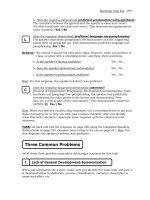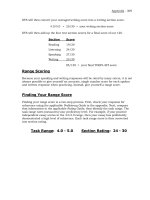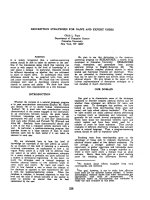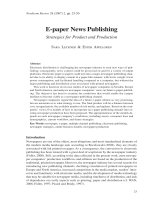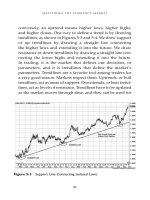Effective strategies for general and special education teachers
Bạn đang xem bản rút gọn của tài liệu. Xem và tải ngay bản đầy đủ của tài liệu tại đây (7.97 MB, 72 trang )
Eastern Michigan University
DigitalCommons@EMU
Senior Honors Theses
Honors College
2009
Effective Strategies for General and Special
Education Teachers
Heather A. Martel
Eastern Michigan University
Follow this and additional works at: />Recommended Citation
Martel, Heather A., "Effective Strategies for General and Special Education Teachers" (2009). Senior Honors Theses. Paper 210.
This Open Access Senior Honors Thesis is brought to you for free and open access by the Honors College at DigitalCommons@EMU. It has been
accepted for inclusion in Senior Honors Theses by an authorized administrator of DigitalCommons@EMU. For more information, please contact
Effective Strategies for General and Special Education Teachers
Abstract
Today’s teachers are asked to educate ALL students using research-based strategies in inclusive classrooms.
The following review will include three research based instructional strategies and one teaching model all of
which are elements that can increase the success of students at risk for learning problems. Instructional
strategies explored in this review are class-wide peer tutoring, direct instruction and the behavioral strategy of
self-monitoring. The teaching model is known as co-teaching, a model which is becoming the norm in schools
in southeast Michigan. It is hypothesized that concrete knowledge of research based instructional methods
that can be used in co-teaching situations may reduce rates of teacher frustration and attrition, and will
improve academic and behavioral performance of students in a variety of settings.
Degree Type
Open Access Senior Honors Thesis
Department
Special Education
Subject Categories
Curriculum and Instruction | Special Education and Teaching
This open access senior honors thesis is available at DigitalCommons@EMU: />
Effective Strategies for General and Special Education Teachers
Heather A. Martel
Karen J. Carney Ph.D. (Sponsor)
Dr. Carole W. Gorenflo
Dr. James A. Knapp
Eastern Michigan University
College of Special Education
Abstract
Today’s teachers are asked to educate ALL students using research-based strategies in
inclusive classrooms. The following review will include three research based
instructional strategies and one teaching model all of which are elements that can
increase the success of students at risk for learning problems. Instructional strategies
explored in this review are class-wide peer tutoring, direct instruction and the behavioral
strategy of self-monitoring. The teaching model is known as co-teaching, a model which
is becoming the norm in schools in southeast Michigan. It is hypothesized that concrete
knowledge of research based instructional methods that can be used in co-teaching
situations may reduce rates of teacher frustration and attrition, and will improve academic
and behavioral performance of students in a variety of settings.
EFFECTIVE STRATEGIES FOR GENERAL AND SPECIAL EDUCATION
TEACHERS
By
Heather A. Martel
A Senior Thesis Submitted to the
Eastern Michigan University
Honors College
in Partial Fulfillment of the Requirements for Graduation
with Honors in Special Education
Approved at Ypsilanti, Michigan, on this date _______________________
_____________________________________________
Dr. Karen J. Carney (Honors Sponsor)
_____________________________________________
Dr. Carole W. Gorenflo (Honors Advisor)
_____________________________________________
Dr. Michael Bretting (Department Head)
_____________________________________________
Dr. James Knapp (Honors Director)
Effective Strategies for General and Special Education Teachers
Introduction
On January 8, 2002, President Bush signed the No Child Left Behind Act (NCLB)
into law. It is designed to ensure that “From this day forward all students will have a
better chance to learn, to excel, and to live out their dreams.”
(www.whitehouse.gov/infocus/achievement/chap12.html). NCLB states that all teachers
are to be highly qualified in the core subjects in every classroom, to use proven, researchbased instructional methods, and timely information and options for parents. Under
NCLB, states are working to close the student achievement gap and make sure all
students achieve academic proficiency, including those who are disabled and
disadvantaged. A vital element in raising achievement scores of students involves using
evidence-based teaching practices. As a result, educators are being asked to successfully
teach ALL students, and to accommodate students who need it (U.S. Department of
Education, 2007).
To meet the requirements put out by NCLB, an increasing number of schools are
moving towards educating students in inclusive classes, where classrooms contain a rich
mix of students who are capable learners and also those at risk (with disabilities, English
language learners, and from low SES backgrounds). In order to teach to students with
such diverse abilities and backgrounds, accommodations need to be made. The
background of the general education teachers for knowing how to make these
accommodations as well as teach to the high standards of NCLB can be an issue. When
accommodations are not made, struggling students fall behind academically and may
exhibit behavior problems. As a result, teachers may become overwhelmed. Reactive
and adverse teaching methods result in teacher frustration and can cause the teachers to
withdraw from their position as an educator (Baker, 2005). However, teachers who are
trained to use various research-based teaching methods, both instructional and behavioral,
are better prepared to educate in diverse learning environments (Baker, 2005).
Literature Review
Research-Based Teaching Methods
The federal government recently allocated funding for research into evidence
based educational practices that have effectively improved student performance
(www.ed.gov/nclb/overview/intro/4pillars.html). In reading, for example, NCLB
supports scientifically based instruction programs in the early grades under the Reading
First program and in preschool under the Early Reading First program. The U.S
Department of Education holds strict requirements for programs to qualify as being
research-based. Studies must take a scientific approach, form a hypothesis, and then try
to prove/disprove the hypothesis. Practices and strategies must be generalizable to
students beyond those involved in the original research. Studies need to show a high
level of effectiveness (www.ed.gov/nclb/overview/intro/4pillars).
Teachers can find the results of this research by reading professional journals,
taking classes at universities, attending conferences, and also by using the internet. The
internet has come to provide the easiest way for teachers to keep abreast of researchbased best practice. Three of the best websites for instructional and behavioral strategies
to use in schools include: www.teachingLd.org which provides trustworthy and up-todate resources designed to teach students with learning disabilities;
www.k8accesscenter.org offers resources which focus on core content areas, as well as
learning and instructional strategies for students with disabilities; and
www.whatworks.ed.gov, established by the U.S. Department of Education, offers
information on effective teaching methods in education. Teachers can use these sites to
find effective strategies for specific behavioral or learning issues in their classroom.
The purpose of this study is to introduce and explain three research-based
strategies that can be used as a tool for teachers who work in inclusive classrooms. It is
also to share a teaching model where general education and special education teachers
can work together in order to be successful with ALL the children in their classrooms.
There are three desired outcomes for this paper.
1. To introduce and clearly define three instructional strategies that are evidencebased, and can have positive effects on all students. Also to share one teaching
model that when done well can enhance the learning of all students in a
classroom.
2. To define key components for achieving successful implementation of each
strategy. Teachers who have a clear understanding of the important details before
using a strategy result in higher student achievement (Greenwood, Delquadri, &
Carta, 1997).
3. To provide an example for each strategy that will aid in connecting the strategy
with “real world” scenarios. These lessons will allow teachers to connect key
ideas with usefulness in the classroom. Once teachers have developed a clear
understanding of the strategies, they can use sample lessons to reference before
beginning implementation.
Strategies introduced in this study were chosen based on success rates and ease of
implementation. Correct use of each strategy will improve student achievement, allow
teachers to have a wider range of instructional alternatives, promote diversified learning
methods for a wide range of student abilities, and help integrate students with special
needs into the general education classroom. Teachers who are equipped with
instructional choices are less frustrated and more productive in the classroom (Baker
2005).
ClassWide Peer Tutoring
Overview.
ClassWide Peer Tutoring (CWPT) is an instructional strategy designed to
effectively teach specific information to students with a variety of skill levels. In CWPT,
students work together to learn a specific set of information. CWPT uses a combination
of instructional components that include partner pairing, systematic content coverage,
immediate error correction, frequent testing, team competition and point earning
(Greenwood et al., 1997). Every student in the classroom is involved in the learning
process with CWPT, which allows them to practice basic skills in a systematic and fun
way (Terry, 2008). CWPT is conducted in a way that encourages positive student
interaction by using partner pairing and peer tutoring. In CWPT, students are taught by
peers who are trained to present a weekly set of information where they can provide
immediate feedback for correct and incorrect responses. Daily lessons allow each partner
to take the role of both the tutor and the tutee (Greenwood et al., 1997). CWPT uses
immediate-response feedback, error correction, and a specific tutoring technique that
benefits both the tutor and tutee. When structured correctly, CWPT allows teachers to
actively engage all students in the classroom, while simultaneously monitoring process
through daily and/or weekly assessments (Maheady, Harper & Mallette, 2003).
Background of strategy.
Research and implementation of ClassWide Peer Tutoring began around 1980. It
was first developed at the Juniper Gardens Children’s Project (JGCP) in Kansas City, by
collaborations of researchers and teachers who were seeking to find a successful
instructional method for integrating children with special needs into general education
settings. In 1997 researchers from the JGCP (Greenwood et al., 1997) published a
CWPT model designed to simplify the process by including reproducible charts and
student handouts specifically designed for easy and accurate implementation and record
keeping.
Two similar class-wide models have emerged: Peer Assisted Learning Strategies
(PALS) (Fuchs, Fuchs, Mathes, & Simmons, 1996), and Reciprocal Peer Tutoring (RPT)
(Fantuzzo & Ginsburg-Block, 1998). PALS is approved by the U.S. Department of
Education’s Effectiveness Panel for Inclusion on effective education practices. PALS for
grades 2-6 has proven effective for increasing the reading performance of English
proficient students with learning disabilities in general education classrooms (Fuchs,
Mathes, & Fuchs , 1997; Simmons, Fuchs, Fuchs, Hodge, & Mathes, 1994; Simmons,
Fuchs, Fuchs, Mathes, & Hodge, 1995). PALS offers specific programs for math and
reading. Reading PALS is available for grades preschool through twelfth grades. Math
PALS is available for Kindergarten through sixth grade. RPT is similar to PALS and
CWPT in that it has a structured format where “students prompt, teach, monitor, evaluate
and encourage each other” (Fantuzzo, King, Heller, 1992, p. 332). In RPT students are
responsible for lesson planning, monitoring, and evaluating student performance. The
idea of RPT is to increase student’s interdependence by allowing freedom of choice
within group settings (www.k8accesscenter.org/index.php/category/peer-tutoring: Using
Peer Tutoring to Facilitate Access).
Research findings.
CWPT has been proven effective with students from pre-school to high school
levels, and has been used in both general and special education classroom settings.
CWPT was initially designed for students in grades 1-6, with diverse skill levels,
including students with learning disabilities, limited English proficiency, and other mild
disabilities. It has since been expanded to include newer models that can be used at any
grade level with proper modification. New uses include “higher order” skills such as
asking thought provoking questions in math and science, and combining class-wide
tutoring components with self-management (King, Staffieri, & Adelgais, 1998). CWPT
has also been used to teach health and safety information to students with mental
disabilities, and improve academic, linguistic, and social competence of English language
learners (Maheady et al., 2003).
Studies on the effectiveness of CWPT have demonstrated an increase in math,
reading, social studies, spelling, and vocabulary skills on students with mild disabilities
and students who are low-achieving (Harper, Maheady, Mallette, & Karnes, 1999).
Results of a study conducted by Veerkamp, Baldwin, Kamps, & Cooper (2007)
demonstrated improved performance on middle-school students’ weekly vocabulary tests
under CWPT conditions compared with teacher-led instruction. Findings from this study
showed that CWPT can improve the reading skills of urban middle school students. In
another middle-school study, students with emotional or behavioral disorders used peer
tutoring to teach paragraph summarization (Spencer & Mastropieri, 2003). In this study,
students scored higher on their social studies content tests and showed higher levels of
on-task behavior during the tutoring compared to traditional instruction. Research has
also indicated strong outcomes for peer tutoring for students with average to low
achievement levels, and students with learning disabilities (Fuchs et al., 1997; Simmons
et al., 1994, 1995).
With proper implementation of CWPT, students who are advanced, average, low
achieving or students with disabilities can increase their mastery of academic skills
(Maheady et al., 2003). Using CWPT can help students raise their achievement levels,
retain information learned in the process and use the information learned for other tasks
(Greenwood et al., 1997).
At least 25 studies have been found showing CWPT to be more effective than
teacher-led instruction (Greenwood, Arreaga-Mayer, Utley, Galvin, &Terry, 2001). It
has also been successful in aiding the inclusion of students with autism into general
education classrooms. Information on the success of CWPT has shown a high degree of
success.
Studies have found lowered student outcomes have attributed to a reduction in
time spent to learn CWPT lessons, low quality peer tutoring, and using unchallenging
student materials (Greenwood et al., 1997). Additional research is needed in early
childhood and high school levels due to current research focus on grades 1-6. Other areas
where additional research would benefit would be the role of specific curricula,
appropriate methods for training teachers to use CWPT, and ways to align instruction
with appropriate grade level content standards and benchmarks (Maheady et al., 2003).
Implementing CWPT.
The object of CWPT is for students to learn weekly information that is presented
and to demonstrate their understanding of this information on assessments. Students will
measure success by their scores on the assessments. In the CWPT presented here, there
can also be a class game format used, so that student can also measure success by the
number of points earned by themselves and their team.
To begin, teachers use pre-tests to measure students’ knowledge of information to
be taught in the week ahead. Typically, knowledge would be low (e.g., 20-40% correct)
on the pretest and increase to 90-100% correct (average) on the posttest (Greenwood et
al., 1997). If the pretest indicates items on the list are too easy or hard, the list should be
modified.
In Greenwood et al’s (1997) CWPT, a class is divided into two teams. Students in
each team are paired with a partner from the same team for the week. Pairing can be set
up randomly or by a student’s skill level. In spelling and math, students may be placed
randomly with a partner as tutors are given answers to help monitor and make
corrections. When using CWPT for reading, partners should be placed in pairs with
contrasting skill levels. High-skill level readers are able to help those who are lowerskilled. Teachers should monitor pairing and make appropriate adjustments (Greenwood
et al., 1997).
Once paired, each partner will take a turn tutoring the other partner by giving a
word to be spelled, a math fact, or by listening to literature being read. The tutors give
points for correct answers, while immediately correcting and recording errors. In
addition, the teacher can provide award points to students for good behavior. The two
teams compete for points and social reinforcement.
In CWPT, students spend approximately 30 minutes per day for four days,
engaged in tutoring with the weekly lesson. The fifth day is used for assessment and pretesting for the following weekly lesson. In the first 10 minutes of each daily lesson, one
student plays the role of tutor and the other as the tutee. For the next 10 minutes the roles
are exchanged. The tutor is responsible for presenting each item on a weekly tutoring list
(Appendix A.2). Two points are to be rewarded for correct answers. If the tutee answers
incorrectly, the tutor makes an immediate correction and later in the lesson allows the
tutee a second chance to answer and practice the correct response, using boxes 1-3 of the
tutoring worksheet (Appendix A.4). At this point, if the student’s answer is correct, the
tutee earns one point. If the answer is still incorrect, no points are awarded for that
particular item. After ten minutes, the tutor and tutee will exchange jobs. If the tutoring
pairs finish prior to the ten minute buzzer, tutors are to start the list again. If either
member from a pair has a question, that student should raise the help sign for teacher
assistance. During partner work, the teacher should tour the classroom, awarding 1-5
bonus points for appropriate behavior.
Students grade their partner’s assessment test and points are awarded for correct
answers. When all points have been reported, the winning team is announced a positive
verbal reinforcement is given or a celebratory round of applause. The winning team
should also be directed to appropriately congratulate the other team for their efforts.
Partners and teams change the following week (Greenwood et al., 1997).
Steps for setting up CWPT.
Effective implementation training for the student is given by the teacher and is
necessary for effective use of CWPT. Before beginning training, teachers should clearly
understand the process and teach it to their students. It is key that students clearly
understand the importance of being respectful throughout the entire process. The
following steps show the suggested instructions for student training of CWPT.
Day 1. Introduce the CWPT strategy, establish goal of increasing skills, establish
expectations for teams and points, winning & losing, and good
sportsmanship.
Day 2. Explain procedures for partnering, who will move or stay in their seat.
Day 3. Explain the use of the tutoring worksheets, first with teacher led practice,
then two student practice, finally whole class practice.
Day 4. Discuss point earning and reporting procedures.
Day 5. Demonstrate how to calculate total points, practice praise, and review
entire process.
Steps for running CWPT.
After spending a week setting up the expectations for CWPT, it is time to begin.
The monthly subject list allows teachers to organize content materials. That content can
then can be transferred onto the weekly tutoring list (Appendix A.1 & A.2). The teacher
should have set up the subject (e.g., spelling, reading, or math) and expectations, based
on a pretest given to the class. Then pairs and teams should be assigned, with the teacher
determining and displaying which students will move and which will stay in their seat. A
sample move/stay chart that may be posted in the classroom (see Appendix A.3).
Students stay in their seat until the teacher gives the direction to move. Moving should
be quick and quiet.
On the first day of the week, teachers should distribute the CWPT worksheets.
This includes a weekly tutoring list (Appendix A.2), providing one per pair; a tutoring
worksheet (Appendix A.4), giving one per student; the tutoring point sheet (Appendix
A.5), giving one to each student; and finally giving each pair a “help sign” (Appendix
A.8) to raise if they need the teacher’s help. Point sheets may be laminated for reuse.
Simple instructions for the tutoring worksheet and tutoring point sheet are written directly
on each worksheet. Worksheets may need to be modified accordingly for younger
students or for students with more severe disabilities. The teacher should take a few
minutes to review CWPT worksheets prior to starting the 30 minute peer tutoring session.
Students can also be reminded of the opportunity of 1-5 bonus points each round for good
behavior.
Student pairs then begin the tutoring sessions. The tutors record points and do
error correction. At the end of the 30 minutes, total numbers are recorded on the team
point chart (Appendix A.6). When all students have reported points, team totals should
be calculated and the winning team announced. Social skill training is important at this
point, encouraging clapping for the “winning team” and also for the great effort of their
opposition. It is also important to check for student understanding or questions about
CWPT. This procedure continues for 4 days of working on the CWPT skill for the week.
On the fifth day, teachers should administer a post-test. The posttest measures each
student’s level of mastery. Post-test scores should be charted on the pre/post test point
chart in Appendix A.7, to show student progress. If adequate progress is not achieved,
the teacher should review information being taught and more closely monitor tutoring
sessions (Greenwood et al., 1997). The strength of this strategy is in keeping track of
student growth on the skills and adjusting as necessary.
Example CWPT lesson.
Choose the information that students should practice (eg. Spelling or math facts).
Figure 1: Weekly Tutoring Spelling List
Tutor: ____________________________Tutee: ________________________________
1. dance
6. snap
2. happy
7. mouse
3. house
8. circle
4. race
9. pretty
5. clap
10. smart
1. Pre-test. The teacher reads words from the weekly tutoring list as students record
answers on a sheet of paper. These may be graded by the teacher or by other
students. Record scores on the pre/posttest score chart.
Figure 2: Pre/Posttest Score Chart
AB= Absent
MS= Missing
WEEK 1
WEEK 2
☺= 100%
STUDENT
11/18/2008
PRE
POST
Michael
Sarah
Matthew
20%
35%
15%
90%
☺
85%
___/___/___
PRE
POST
1. Establish peer partners and teams. Give out the weekly tutoring list (Appendix
A.3), the tutoring worksheet (Appendix A.4), the tutoring point sheet (Appendix
A.5), and the help sign (Appendix A.8).
2. The tutor reads a word aloud. The tutee spells the word aloud and writes it on the
tutoring worksheet. If a word is misspelled, the tutor says the word again and
spells it correctly. The tutee correctly spells the word and writes it three times on
the worksheet.
Figure 3: Tutoring Worksheet
Tutee Name: ___________________________ Date: ____________________________
1
2
3
Happy
Happy
happy
1. dance
2. hapie
3. pretty
3.
Allow 30 minutes a day for peer partners to practice the skills and teach them
how to record their partner’s success each day. Teach students to record their
daily points (Appendix A.5). For correct answers on the first try, the tutee earns
two points. Correct answers on the second try earn the tutee one point. If the
tutee makes an error on the second try, he/she will not earn any points for that
word. At the end of the daily lesson, the teacher calls on each student to report
their point earnings and records findings on the Team Point Chart (Appendix
A.6).
Figure 4: Tutoring Point Sheet
Student: _____________________ Date: _____________ Subject: _______________
Number of times practiced: 1 2 3 4 5 6
7 8 9 10
1
2
3
4
5
6
7
8
9
10
11
12
13
14
15
16
17
18
19
20
21
22
23
24
25
26
27
28
29
30
31
32
33
34
35
36
4. Post-test and analysis. The teacher reads each word aloud, while all students
write the word on a piece of paper. Students or the teacher grades the post-tests
and records the scores on the Pre/Posttest Score Chart. When all results have
been turned in, the teacher compares the Pretest scores with the posttest scores
and congratulates students for their hard work and progress (Appendix A.1).
5. Repeat.
Class wide peer tutoring uses a student-centered learning approach that transfers the
teaching and learning responsibilities from teacher to student. The main role of the
teacher is to teach initial instruction and monitor progress of the tutoring environment.
Another research validated instructional approach called direct instruction (DI) presents
ideas which are contrasting to CWPT. Direct Instruction uses a teacher-centered
approach, in which learning is dependent on the quality of presentation by the teacher.
Direct Instruction
Overview.
Direct instruction (DI) is a scientifically-based instructional approach that has
proven results for students with disabilities. The DI approach uses detailed teaching
procedures that are presented in a specific order (Tarver, 1999). It is built around the
concept that every child can learn if we teach them carefully and teachers can be
successful with effective instructional delivery techniques. In DI, it is the teacher who is
responsible for student learning. A common phrase that refers to DI is, "If the learner
hasn't learned, the teacher has not taught" (Tarver, 1999). There are three main
components to the design and delivery of DI programs which include program design,
organization of instruction, and teacher/student interactions (Marchand-Martella, Slocum,
& Martella, 2004).
Program design focuses on careful content design that allows students to make
generalizations about a topic. The wording and timing are important part of clear
communication in instruction. Sequencing of information taught is important in building
upon information the students should already know. Teachers need to focus on basic
skills before moving to more advanced ideas. All information taught using DI should be
repeated multiple times to ensure a concrete understanding of information from students.
DI encourages clear instructional formats that provide specific directives of teacher and
student dialogue.
The organization of materials should include groups of information based on
current skill levels. Teacher flexibility with regards to timing allows students to perform
for longer periods of time with a higher success rate. Assessments of this success is
measured continuously.
Teacher-/student interactions include immediate student response, choral
responses from students, and timed signaling from the teacher. The pacing of instruction
is crucial in successful teaching. The focus of DI is on student mastery of information
that is taught by the teacher. DI follows a specific correction procedure where the teacher
models the procedure, leads the class in instruction, provides an assessment, and re-tests
the information presented in each lesson (Marchand-Martella et al., 2004).
Background.
Direct instruction has been proven in the largest educational study to date called
Project Follow Through. DI was first developed by preschool teacher Siegfried (Zig)
Engelmann. He began research and experimentation with direct instruction in 1963. Zig
first began using his strategies with his 3year old twin sons. When his sons were age
four, Zig had taught them multi-digit multiplication, addition of fractions with like and
unlike denominators, and basic algebraic concepts using only 20 minutes a day. Seeing
his son’s rapid achievement, Zig thought he might be able to accomplish the same results
with any child, especially children of poverty. He theorized that children would quickly
improve performance levels by using carefully engineered instruction, rather than waiting
for them to learn through random experience.
Around 1966, Wes Becker became the director of the preschool department at the
school where Zig worked. Wes and Zig became the Engelmann-Becker team and joined
Project Follow Through (FT) under the sponsorship of the University of Illinois in 1967.
Project FT began in 1967 as part of President Johnson's War on Poverty and continued
until the summer of 1995, having cost about a billion dollars. Project FT was a
concentrated effort to break the cycle of poverty through improved education. Zig began
sharing his expertise with other teachers in the form of the Direct Instruction System for
Teaching Arithmetic and Reading (DISTAR or Direct Instruction). His rapid progress
with disadvantaged students began gaining attention. DI was officially introduced in
1968, based on the work of Siegfried Engelmann, currently a professor at the University
of Oregon and Director of the Association for Direct Instruction (Grossen, 1996).
Data from Project FT showed superior results for DI when compared to other
models of instruction on measures of basic skills, cognitive-conceptual skills, and
affective skills (Tarver, 1999). FT showed large gains for both general and special
education, as well as both elementary and secondary students (Adams & Engelmann,
1996). It also showed lasting advantages through high school for students taught with DI
in grades K-3 (Meyer, 1984). A high level of student achievement has been reported by
individual research studies, research reviews, and technical reports (Tarver, 1999).
Research findings.
Direct instruction is supported by more research than any other instructional
program (Watkins & Slocum, 2004). Extensive research specifically shows positive
outcomes for at-risk and special education populations (Marchand-Martella et al., 2004).
In fact, Forness, Kavale, Blum, and Lloyd (1997) conducted an analysis of various
intervention programs for students receiving special education services and found DI to
be one of seven interventions with strong evidence of success.
DI has been proven to be an effective instructional strategy for teaching reading,
language arts, spelling, and math (www.k8accesscenter.org/documents/Instructional
Methods and Practices). In 1999, the American Institutes of Research (AIR) reported
that out of twenty-four studies they conducted, DI was one of three programs that
presented solid and positive evidence of student achievement (Vukmir, 2002). Figure 5
shows Reading, math, spelling and language achievement for nine models of teaching
(Coombs, 1998; also in Appendix A.9). Scores above the horizontal line indicate a
positive effect of the program on achievement in that skill area compared with the
"control" students who did not participate in the project. Scores below the horizontal line
indicate a negative effect, compared with control groups (Coombs, 1998). Models of
instruction that took a direct instruction approach achieved the greatest gains observed in
the area of thinking and problem-solving skills. DI offers the idea that the best way to
improve a child's school performance is to focus on basic skills. Proponents of DI state
that higher thinking and problem-solving and heightened self-esteem, result from mastery
of the basic skills (Johnson & Layng, 1992).
Figure 5: Comparative analysis of nine Project Follow Through models.
Implementation of direct instruction.
Information presented in DI is carefully scripted before the lesson begins.
Teachers give instruction using rapid fire responses combined with immediate error
correction. Students respond on average at a rate of about 10 responses per minute.
Students respond as a group (chorally) or sometimes individually. DI is fast paced and its
success depends on lesson design, and the action and reactions of the teacher (modeling).
Teachers provide frequent positive feedback or corrections. Lessons should offer
opportunities for students to practice using skills that are taught on multiple occasions.
Information taught should be repeated over time to reinforce learning. In DI repetition is
a key factor of concrete learning.
Sample direct instruction lesson.
The following is an example of a social skill lesson using a direct instruction
approach. This lesson is adapted from Kostewicz, Ruhl, and Kubina, 2008.
Objective: Students will be able to repeat the rule “Raise your hand before talking” and
be able identify two examples and two non-examples with 100% accuracy.
Rationale: “Raising you hand before talking is very important in the classroom. It
allows all students to have a chance to answer questions being asked. Now
we are going to practice appropriate responses when questions are asked.”
Lesson:
Teacher: “The appropriate response for answering a question is to raise your
hand before talking. What is the correct way to answer a question? Get ready.”
Signal
Class response: “Raise your hand before talking”
Teacher: “Excellent. What is the right way to answer a question? Get ready.”
Signal
Class response: “Raise your hand before talking.”
Teacher: “Good. Now we are going to practice some times that people do and do
not raise their hand before talking. Class, am I raising my hand before talking
when sit quietly in my seat with my hand raised in the air? Get ready.” Signal
Class response: “Yes.”
Teacher: “Good. Am I raising my hand before talking when I jump up and down
saying “ooh, ooh, ooh, pick me, pick me”? Get ready.” Signal
Class response: “No.”
Teacher: “Good listening. Am I raising my hands before talking when I am
sitting on the group carpet, staring at the teacher, and holding my hand in the air?
Get ready.” Signal
Class response: “Yes.”
Teacher: “Yes. How about if I am clapping to get the teacher attention? Get
ready.” Signal
Class response: “No.”
Teacher: “Your turn, can someone tell me a time when they raised their hand
before talking? (Take two responses and briefly discuss.)
Teacher: “Great job, everyone. I am going to act out a few situations and ask you
each time: Am I raising my hand before talking?” (Possible ask for student
helpers, act out 2 examples and 2 non-examples, and a response from the class
each time.)
Teacher: “Great job everyone! Remember, raise your hand before talking, even
when answering a question that was asked.”
Lesson practice should occur repeatedly to ensure students clear understanding.
Direct instruction takes only a small amount of time to practice, but shows impressive
progress by students. Teachers who use this type of teaching strategies along with others
